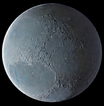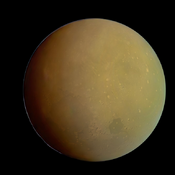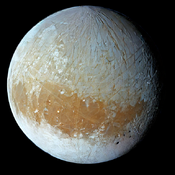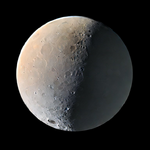Cyadon
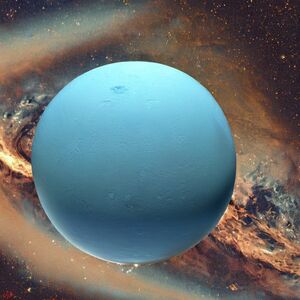 The image of the planet Cyadon in the artist's view | |||||||||||||
| Orbital characteristics | |||||||||||||
|---|---|---|---|---|---|---|---|---|---|---|---|---|---|
| Aphelion | 5.45705 AU (816.363 Gm) | ||||||||||||
| Perihelion | 4.95057 AU (740.595 Gm) | ||||||||||||
| 19.386 Gm (0.12959 AU) | |||||||||||||
| Eccentricity | 0.0489 | ||||||||||||
| |||||||||||||
Average orbital speed | 44.89 km/s | ||||||||||||
| 292.55° | |||||||||||||
| Inclination |
| ||||||||||||
| 51.6° | |||||||||||||
| Known satellites | 25 (satellites ofCyadon) | ||||||||||||
| Physical characteristics | |||||||||||||
Mean radius | 25,362±7 km | ||||||||||||
Equatorial radius | 25,559±4 km 4.007 Earths | ||||||||||||
Polar radius | 24,973±20 km 3.929 Earths | ||||||||||||
| Flattening | 0.0229±0.0008 | ||||||||||||
| Circumference | 159,354.1 km | ||||||||||||
| 8.1156×109 km2 15.91 Earths | |||||||||||||
| Volume | 6.833×1013 km3 63.086 Earths | ||||||||||||
| Mass | 1.039824×1026 kg 14.536 Kelera's GM=5,793,939±13 km3/s2 | ||||||||||||
Mean density | 1.27 g/cm3 | ||||||||||||
| 8.69 m/s2 0.886 g | |||||||||||||
| 0.23 | |||||||||||||
| 21.3 km/s | |||||||||||||
| −0.37573 d −9 h 01 m 03 s | |||||||||||||
Equatorial rotation velocity | 2.59 km/s 9,320 km/h | ||||||||||||
| 29.09° (to orbit) | |||||||||||||
North pole right ascension | 257.311° | ||||||||||||
North pole declination | −15.175° | ||||||||||||
| Albedo | 0.300 (Bond albedo) 0.488 (Geometric albedo) | ||||||||||||
| |||||||||||||
| 3.3″ to 4.1″ | |||||||||||||
| Atmosphere | |||||||||||||
| 27.7 km | |||||||||||||
| Composition by volume | Below 1.3 bar (130 kPa):
| ||||||||||||
Cyadon or Tau Lanus d is the third planet from the Star and the largest in the Tau Lanus System. Cyadon is an ice giant, unlike gas giants, consisting mainly of hydrogen and helium, there is no metallic hydrogen in the depths of Cyadon, but there is a lot of ice in its high-temperature modifications. For this reason, experts have classified it in the category of "ice giants". The basis of the atmosphere of Cyadon is hydrogen and helium. It has the coldest atmosphere in the Tau Lanus system, with a minimum temperature of 49 kelvins (−224 °C; −371 °F). He it has a complex, layered cloud structure; water is thought to make up the lowest clouds and methane the uppermost layer. The planet's interior is mainly composed of ices and rock. Cyadon was found to have 25 natural satellites. The four main satellites are Cyadon 1, Cyadon 2, Cyadon 3 and Cyadon 4. Cyadon as an almost featureless planet in visible light, without the cloud bands or storms associated with the other giant planets. Wind speeds can reach 250 metres per second (900 km/h; 560 mph). The planet and its moons are located at the outer edge of the habitable zone.
Discovery and exploration
Within the framework of the program "KELERA: Knowledge Exploration and Long-term Expansion for Resource Acquisition", a team of scientists and researchers went on a mission to discover and explore the planet of the ice (gas) giant Cyadon. Their goal was to extract helium-3, a rare isotope that was necessary for the operation of thermonuclear installations.
The journey to the stadium was long and treacherous, as the planet was located in a remote corner of the galaxy, in the system of the red dwarf Tau Lanus. The team had to pass through the asteroid belt using advanced sensors and propulsion systems to avoid collisions and not get off course.
After a very long journey, the team finally arrived at the stadium - a frozen world shrouded in a thick layer of clouds and fog. The autonomous helium-3 mining station was located between the low orbit and the upper layers of the atmosphere, and the working colony is located on the second satellite of the Ice Giant - Cyadon 2.
Name
The name "Cyadon" could be derived from a combination of two words: "Cya" (meaning "icy" or "frosty") and "don" (meaning "lord" or "ruler"). This name could be fitting for a planet that is dominated by icy conditions and extreme weather patterns, with a harsh environment that only the strongest and most resilient lifeforms can survive.
satellites of Cyadon
The ice (gas) giant Cyadon was not only home to a wealth of resources, but it also had a fascinating system of moons orbiting around it. In total, there were 25 natural satellites that had been discovered and the four main satellites are Cyadon 1, Cyadon 2, Cyadon 3 and Cyadon 4.
